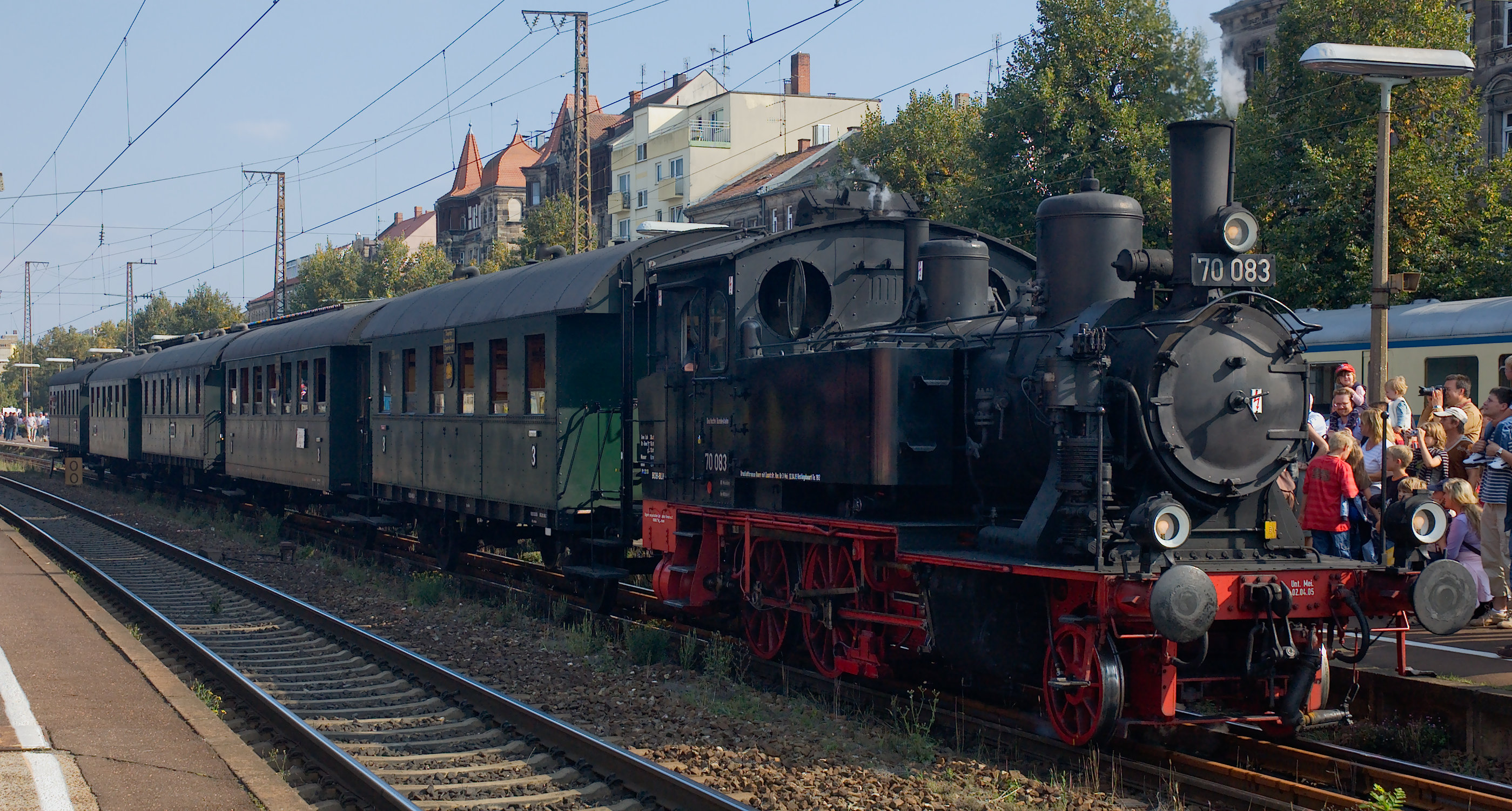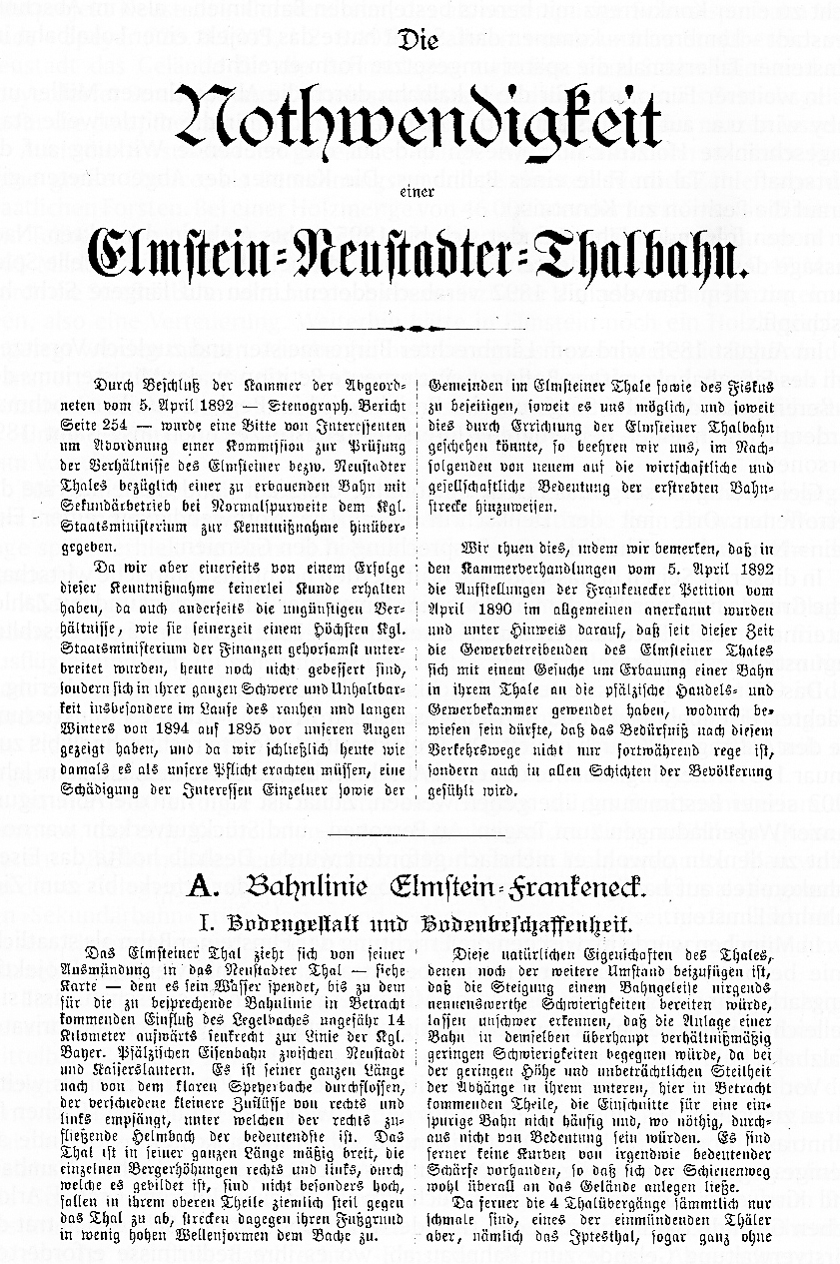|
DGEG
The German Railway History Company (''Deutsche Gesellschaft für Eisenbahngeschichte'') or DGEG is a society concerned with the history of the railways. The objectives of the society are: * to generate and maintain interest and understanding for the history of the railways within the framework of overall history, * to foster scientific studies in this area, * to preserve and maintain important cultural and technological monuments. History The society was founded on 22 April 1967 in Karlsruhe and was entered on the official register of clubs and societies there. Members of the society were able to gradually restore the Bochum-Dahlhausen locomotive shed and its surroundings to their former condition after their closure by the Deutsche Bundesbahn on 1 August 1969. Because the arrival of railway vehicles was imminent in 1972 and Dahlhausen was still not totally ready, the locomotive shed next to the workshop building of the old Neustadt/Haardt locomotive shed was rented. In 1981 then ... [...More Info...] [...Related Items...] OR: [Wikipedia] [Google] [Baidu] |
Bochum Dahlhausen Railway Museum
The Eisenbahnmuseum Bochum-Dahlhausen is a railway museum situated south of the city of Bochum in the state of North Rhine-Westphalia, Germany. It was founded by DGEG, the German Railway History Company in 1977 and is based in a locomotive depot that was built between 1916 and 1918 and ceased operation in 1969. Then DGEG took over the whole area of 46,000 square metres and built up the biggest railway museum in Germany. In the middle of the museum, there is an engine shed with fourteen tracks. A preserved turntable, coaling, watering, and sanding facilities are still in operation. This museum is integrated into The Industrial Heritage Trail (''Route der Industriekultur'') a route of monuments from the history of the industry. Exhibits The origins of the vehicle collection go back to 1967. A variety of steam locomotives and other technically interesting railway vehicles from different epochs are displayed. There are over 200 exhibits in total. The stars of the exhibition are the h ... [...More Info...] [...Related Items...] OR: [Wikipedia] [Google] [Baidu] |
Neustadt/Weinstraße Railway Museum
The Neustadt/Weinstrasse Railway Museum (''Eisenbahnmuseum Neustadt/Weinstraße'') is one of the two railway museums run by the German Railway History Company, (''Deutsche Gesellschaft für Eisenbahngeschichte'') or DGEG. It is located in the station at Neustadt an der Weinstraße. The other one is the Bochum Dahlhausen Railway Museum. The Neustadt/Weinstrasse Railway Museum is housed in the historic locomotive shed of the Palatinate Railway, built in the very earliest days of the railways. in what was then the Bavarian Palatinate or ''Pfalz''. The engine shed is still largely in its original condition. Exhibits The focus of the Neustadt/Weinstrasse Railway Museum is vehicles of the former state railways in southern Germany. For example, the two remaining examples of steam locomotives from the time of the Palatine Railways are preserved here still in their original state: the T 1 ''Schaidt'' and a Palatine T 5. In addition a replica of an express train locomotive from the ea ... [...More Info...] [...Related Items...] OR: [Wikipedia] [Google] [Baidu] |
Bavarian Localbahn Society
The Bavarian Localbahn Society (''Bayerischer Localbahnverein e.V.'' or BLV), with its headquarters in Tegernsee, is a society that is concerned with the history of the railways in Bavaria. ''Localbahn'' (sometimes ''Lokalbahn''; literally: 'local line') means 'branch line' and is mainly used in southern Germany and Austria in lieu of the usual term ''Nebenbahn''. The BLV's objectives are the operation of historic trains and the collection of historically valuable railway items from Bavaria. Operations The society runs the ''Localbahn Museum'' in Bayerisch Eisenstein and a locomotive shed in Landshut. It also operates the museum railway Tegernsee-Schaftlach-Holzkirchen Localbahn Museum The BLV dedicated its museum to the once common branch lines of the railway - called ''Vicinalbahnen'', ''Sekundärbahnen'' or ''Localbahnen'' - which connected most of Bavaria in the 19th century. Many of them have now fallen prey to the structural changes or have been changed to suburban train ... [...More Info...] [...Related Items...] OR: [Wikipedia] [Google] [Baidu] |
Little Cuckoo Railway
The Cuckoo Railway (german: Kuckucksbähnel, literally "Little Cuckoo Railway"), in its early days the Elmstein Valley Railway (''Elmsteiner Talbahn''), is a 12.97 kilometre long branch line A branch line is a phrase used in railway terminology to denote a secondary railway line which branches off a more important through route, usually a main line. A very short branch line may be called a spur line. Industrial spur An industri ... in the central Palatine Forest, which runs through the region of Neustadt an der Weinstraße, Neustadt/Kaiserslautern from Lambrecht (Pfalz), Lambrecht to Elmstein. It was built primarily to support the local forestry industry. In 1902 the section to Sattelmühle (Esthal), Sattelmühle was opened, initially just as an industrial siding. In 1909 it was extended to Elmstein and upgraded to a fully fledged branch line. Regular passenger services were withdrawn in 1960 - due to the sparse population of the region it had always played a secondary role ... [...More Info...] [...Related Items...] OR: [Wikipedia] [Google] [Baidu] |
Werl
Werl (; Westphalian: ''Wiärl'') is a town located in the district of Soest in North Rhine-Westphalia, Germany. Geography Werl is easily accessible because it is located between the Sauerland, Münsterland, and the Ruhr Area. The Hellweg road runs through the city, as Werl is a part of the fertile Bördelandschaft of the Werl–Unnaer Börde. Neighbouring municipalities Division of the town Werl consists of the following districts: * Blumenthal (48 inhabitants) * Budberg (596 inhabitants) * Büderich (3107 inhabitants) * Hilbeck (1339 inhabitants) * Holtum (1049 inhabitants) * Mawicke (521 inhabitants) * Niederbergstraße (210 inhabitants) * Oberbergstraße (363 inhabitants) * Sönnern (870 inhabitants) * Westönnen (2665 inhabitants) * Werl (22151 inhabitants) History Werl was a member of the Hanseatic League in the Middle Ages and since 1661 has had a statue of the Virgin Mary, making it a place of pilgrimage. Today this relic is in the Wallfahrtsbasilika and is loo ... [...More Info...] [...Related Items...] OR: [Wikipedia] [Google] [Baidu] |
Heritage Railways In Germany
Heritage may refer to: History and society * A heritage asset is a preexisting thing of value today ** Cultural heritage is created by humans ** Natural heritage is not * Heritage language Biology * Heredity, biological inheritance of physical characteristics * Kinship, the relationship between entities that share a genealogical origin Arts and media Music * ''Heritage'' (Earth, Wind & Fire album), 1990 * ''Heritage'' (Eddie Henderson album), 1976 * ''Heritage'' (Opeth album), 2011, and the title song * Heritage Records (England), a British independent record label * Heritage (song), a 1990 song by Earth, Wind & Fire Other uses in arts and media * ''Heritage'' (1935 film), a 1935 Australian film directed by Charles Chauvel * ''Heritage'' (1984 film), a 1984 Slovenian film directed by Matjaž Klopčič * ''Heritage'' (2019 film), a 2019 Cameroonian film by Yolande Welimoum * ''Heritage'' (novel), a ''Doctor Who'' novel Organizations Political parties * Heritage (Armenia) ... [...More Info...] [...Related Items...] OR: [Wikipedia] [Google] [Baidu] |
Railway Museums In Germany
Rail transport (also known as train transport) is a means of transport that transfers passengers and goods on wheeled vehicles running on rails, which are incorporated in tracks. In contrast to road transport, where the vehicles run on a prepared flat surface, rail vehicles (rolling stock) are directionally guided by the tracks on which they run. Tracks usually consist of steel rails, installed on sleepers (ties) set in ballast, on which the rolling stock, usually fitted with metal wheels, moves. Other variations are also possible, such as "slab track", in which the rails are fastened to a concrete foundation resting on a prepared subsurface. Rolling stock in a rail transport system generally encounters lower frictional resistance than rubber-tyred road vehicles, so passenger and freight cars (carriages and wagons) can be coupled into longer trains. The operation is carried out by a railway company, providing transport between train stations or freight customer facili ... [...More Info...] [...Related Items...] OR: [Wikipedia] [Google] [Baidu] |
Museums In Germany
This is a list of museums and galleries in Germany. Baden-Württemberg Bavaria Augsburg * Augsburg Puppet Theater museum * Augsburg Railway Park * Fuggerei museum * German Ice Hockey Hall of Fame Bayreuth * Kunstmuseum Bayreuth Eichstätt * Jura Museum Feucht * Hermann Oberth Space Travel Museum Kempten * Alpin-Museum, largest museum in Europe of the history of the Alpes Munich ;Art museums * Alte Pinakothek * Bavarian National Museum * Bavarian State Archaeological Collection * Bavarian State Painting Collections * Glyptothek * Goetz Collection * Haus der Kunst * Lenbachhaus * Munich Residenz * Munich Stadtmuseum * Museum Brandhorst * Neue Pinakothek * Pinakothek der Moderne * Schackgalerie * Staatliche Antikensammlungen * Staatliche Sammlung für Ägyptische Kunst * Museum Five Continents ;Cultural history museums * Marstallmuseum * Deutsches Brauereimuseum * Deutsches Jagd- und Fischereimuseum * Jewish Museum Munich * Valentin-Museum in the Isartor ;Natura ... [...More Info...] [...Related Items...] OR: [Wikipedia] [Google] [Baidu] |
List Of Prussian Locomotives And Railbuses
This list gives an overview of the locomotives and railcars that were in the Prussian state railways. Also included are the locomotives of the Grand Duchy of Hesse State Railways (''Grossherzoglich Hessischen Staatseisenbahnen'') and the Prussian-Hessian Railway Company (''Preussisch-Hessischen Eisenbahngemeinschaft''). Locomotive classification 1883 classification system Up to 1 April 1883 the Prussian state railways or acquired private railways designated their locomotives with names and/or numbers. From that date the following numbering scheme was introduced into all the railway divisions. This scheme applied to all state railway divisions and state-managed private railways. Locomotive numbering was organised according to the above system. However a locomotive could only be identified exactly by using the divisional name and running number in combination. Because of the increasing numbers of locomotives being procured, the classification scheme and its range of number ... [...More Info...] [...Related Items...] OR: [Wikipedia] [Google] [Baidu] |
List Of Bavarian Locomotives And Railbuses
A ''list'' is any set of items in a row. List or lists may also refer to: People * List (surname) Organizations * List College, an undergraduate division of the Jewish Theological Seminary of America * SC Germania List, German rugby union club Other uses * Angle of list, the leaning to either port or starboard of a ship * List (information), an ordered collection of pieces of information ** List (abstract data type), a method to organize data in computer science * List on Sylt, previously called List, the northernmost village in Germany, on the island of Sylt * ''List'', an alternative term for ''roll'' in flight dynamics * To ''list'' a building, etc., in the UK it means to designate it a listed building that may not be altered without permission * Lists (jousting), the barriers used to designate the tournament area where medieval knights jousted * ''The Book of Lists'', an American series of books with unusual lists See also * The List (other) * Listing (di ... [...More Info...] [...Related Items...] OR: [Wikipedia] [Google] [Baidu] |
List Of DRG Locomotives And Railbuses
The railway vehicle classes covered by this list of DRG locomotives and railbuses belonged to the ''Deutsche Reichsbahn-Gesellschaft'' or DRG (1924–37) and its successor, the ''Deutsche Reichsbahn'' or DRB (post 1937). The DRG (lit. German Imperial Railway Company) was formed under the terms of the Dawes Plan from the ''Deutsche Reichseisenbahnen'' (lit. Imperial Railways), a merger of the various German state railways after the First World War. The tables are generally organized in accordance with the DRG's numbering schemes for the various types of vehicles. A brief explanation of this may be found in the articles on the numbering scheme of the German railways and German steam locomotive classification. After the end of the Second World War the West German part of the DRB became the ''Deutsche Bundesbahn'' (DB), but its East German counterpart continued to be called the ''Deutsche Reichsbahn'' (DR) – see Deutsche Reichsbahn (East Germany). The DB and the DR later introduced ... [...More Info...] [...Related Items...] OR: [Wikipedia] [Google] [Baidu] |
.jpg)


